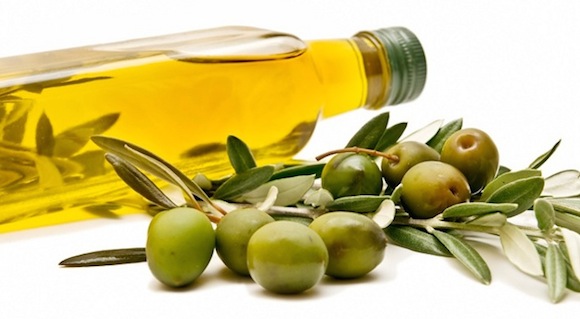 As is the case with most food products that get the green light for health, there seems to be an overwhelming variety of olive oils these days. A trip to Whole Foods the other day revealed about a dozen different kinds of extra virgin olive oil.
As is the case with most food products that get the green light for health, there seems to be an overwhelming variety of olive oils these days. A trip to Whole Foods the other day revealed about a dozen different kinds of extra virgin olive oil.
Extra virgin olive oil is a star player in my pantry, and for good reason. Olive oil is high in monounsaturated fats – the type of fat that helps reduce our risk of heart disease, lower cholesterol and improve insulin levels in our bloodstream. Olive oil is high in omega-3 fatty acids and is is anti-inflammatory. I use it for most of my cooking.
Many people have asked me about the potential dangers of cooking with extra virgin olive oil. The concern is around heating olive oil past its smoke point (the temperature that it will literally start to smoke) and, in turn, oxidize all those good properties of the oil, making it actually harmful for you. Olive oil has a smoke point somewhere in between 365 degrees F and 425 degrees F. If you are sautéing, roasting or baking over medium heat, it is perfectly okay to use olive oil. If you are deep frying or really turning up the heat (which I have been known to do on more than one occasion) then switch to an oil with a higher smoke point, such as organic canola oil or peanut oil.
But before we even cook, we need to choose an olive oil, and this is where the mass confusion comes in. Not only are there different grades of olive oil (extra virgin, virgin, “lite”) there are also cold pressed, first pressed, artisan, etc. And let’s not forget region. There are also rumors of olive oil being adulterated with other oils such as soybean oil. So let’s get to the bottom of things right now, shall we?
Getting Good Grades
Let’s start with the grades of olive oil you might see and cut to the chase: the only olive oil you should be buying is extra virgin olive oil. Olive oil goes through a pressing to release their oils. The first pressing is going to have to most nutrients, and be darker and more flavorful. The next round of presses produces virgin olive oil and then onto lite olive oil. These two aren’t worth the money since half the reason you are using olive oil is for its nutritional benefits. The other reason is taste, which these don’t even come close to an extra virgin.
Now For The Marketing Tactics
You might have been floating down the aisles of Whole Foods or your grocery store and noticed that some pushy olive oils have the words “first cold pressed” or “unfiltered olive oil” shouting from their labels. Is one better than the other? Should they be pressed and unfiltered?
In a word, yes.
But here’s the catch. Any extra virgin olive oil is automatically first cold pressed. However, this says nothing for the quality of the olive oil, where it is from, the taste or the price. As far as unfiltered olive oil, I think of this as removing the pulp from orange juice. The small particles from the olives remain in the bottle (gravity naturally letting them sink) but they contribute so much flavor. Unfiltered is the way to go in my opinion. Not necessary, but nice for added flavor.
What Cold Pressed, Unfiltered Extra Virgin Olive Oil Should You Pick?
Okay, you have narrowed it down to an extra virgin, cold pressed, unfiltered olive oil. And the questions turn to price, taste, look of the bottle or label (I am very guilty of picking wine or olive oil simply because I liked the label!). Here are some things to consider when buying a good olive oil:
Think By Region. Most olives are grown in Italy, Spain, Greece or California. If a label says “product of Spain” it does not necessarily mean that the olives were grown there, just processed there. Seals and designations are symbolic of quality. For example, in the United States you will see The California Olive Oil Council (COOC) stamp of approval on a bottle.
Flavor and Price. We, of course, want our olive oil to taste great without breaking the bank. A good rule of thumb is to use a less expensive oil for cooking and a more expensive oil for using straight on salads or dipping. This might be a process for you, like finding your favorite wine. Olive oils are typically described as “fruity” “peppery” or “buttery”, same as wine.
But what if we were running into the grocery store to pick up some ingredients for tonights dinner? Two extra virgin olive oils I have liked are Columela for using straight and Colavita for cooking (these also got good reviews in taste tests). Remember, these are grocery store oils, not artisan oils straight from a small vineyard in Greece. That’s a whole world of difference. The best strategy is to experiment and find what tastes best for you.
Olive Oil, How Do I Use Thee?
What would we do without the fruity, sharp taste of extra virgin olive oil? Besides the obvious (sautéing, roasting and salad dressings), olive oil can be used in pestos, on top of pasta, as part of a marinade or as a healthy dip for bread. I am always mad for pesto; try my recipe for Broccoli Rabe Pesto over brown rice or whole wheat noodles.
Now I would love to hear from you. Have you ever been confused when buying olive oils? What brands do you usually buy? Let me know in the comments below!



